by Maria Popova Twain and Bambino, Browning and Flush, Dickens and Grip, Hemingway and Uncle Willie, and more.
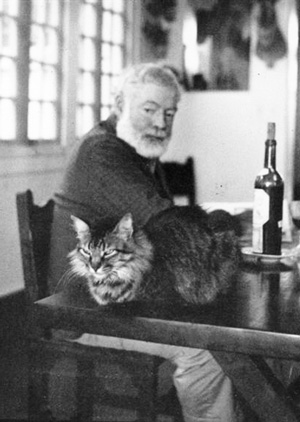 The wonderful recent Lost Cat memoir, one of my favorite books of the past few years, reminded me of how central, yet often unsuspected, a role pets have played in famous authors? lives throughout literary history.
The wonderful recent Lost Cat memoir, one of my favorite books of the past few years, reminded me of how central, yet often unsuspected, a role pets have played in famous authors? lives throughout literary history.
Cats have inspired Joyce?s children?s books, T. S. Eliot?s poetry, Gay Talese?s portrait of New York, and various literary satire, while dogs have fueled centuries of literature, philosophy and psychology, interactive maps, and some of the New Yorker?s finest literature and art. Gathered here are some of literary history?s most moving accounts of famous writers? love for their pets, culled from a wealth of letters, journals, and biographies.
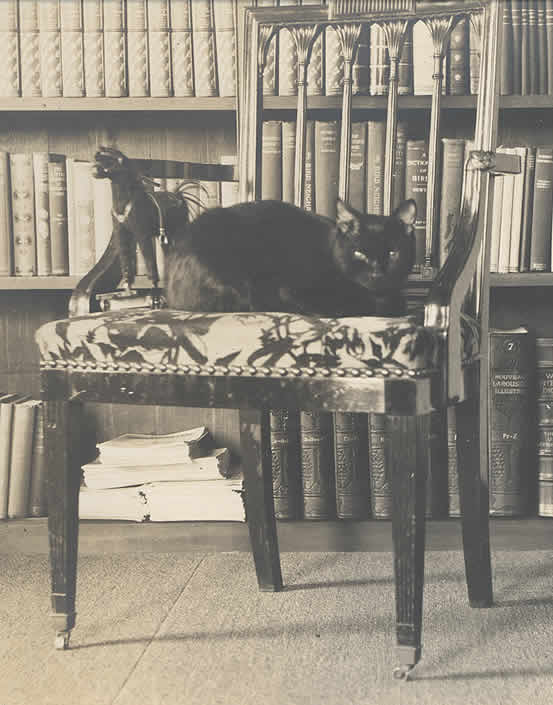
Bambino, photographed by Mark Twain's daughter, Jean Clemens (Image: Mark Twain Papers, University of California, Berkeley)
In between dispensing advice to little girls and epistolary snark to audacious grown-ups, Mark Twain grew deeply fond of the cat he had gotten for his daughter Clara during her extended illness. Writing in My Father, Mark Twain, Clara remembers:
In the early autumn Father rented a house on Fifth Avenue, corner of Ninth Street, number 21, where he, Jean, the faithful Katie, and the secretary settled down for the winter. I was taken to a sanatorium for a year. During the first months of my cure I was completely cut off from friends and family, with no one to speak to but the doctor and nurse. I must modify this statement, however, for I had smuggled a black kitten into my bedroom, although it was against the rules of the sanatorium to have any animals in the place. I called the cat Bambino and it was permitted to remain with me until the unfortunate day when it entered one of the patient?s rooms who hated cats. Bambino came near giving the good lady a cataleptic fit, so I was invited to dispose of my pet after that. I made a present of it to Father, knowing he would love it, and he did. A little later I was allowed to receive a limited number of letters, and Father wrote that Bambino was homesick for me and refused all meat and milk, but contradicted his statement a couple of days later saying: ?It has been discovered that the reason your cat declines milk and meat and lets on to live by miraculous intervention is, that he catches mice privately.?
One day, however, Bambino disappeared, and Twain took out an ad in the New York American, offering $5 for Bambino?s return and the following description:
Large and intensely black; thick, velvety fur; has a faint fringe of white hair across his chest; not easy to find in ordinary light.
Katy Leary, Twain?s faithful servant, recalls the incident in A Lifetime with Mark Twain:
One night he got kind of gay, when he heard some cats calling from the back fence, so he found a window open and he stole out. We looked high and low but couldn?t find him. Mr. Clemens felt so bad that he advertised in all the papers for him. He offered a reward for anybody that would bring the cat back. My goodness! the people that came bringing cats to that house! A perfect stream! They all wanted to see Mr. Clemens, of course.
Two or three nights after, Katherine heard a cat meowing across the street in General Sickles? back yard, and there was Bambino ? large as life! So she brought him right home. Mr. Clemens was delighted and then he advertised that his cat was found! But the people kept coming just the same with all kinds of cats for him ? anything to get a glimpse of Mr. Clemens!
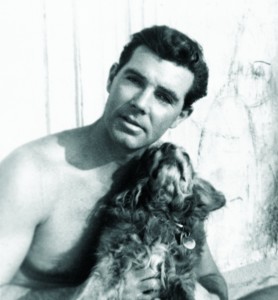
Robert Pole and Tavi
Robert Pole, Ana?s Nin?s ?West Coast Husband,? was inseparable from his beloved spaniel named Tavi. A series of letters between the two, found in A Cafe in Space: The Anais Nin Literary Journal, Volume 5, embodies the tender soul-merging that happens when a significant other?s pet comes to move our own hearts with equal might. In early May of 1960, Pole writes:
My Love:
Quel jours! After wrote you from beach took Tavi to McWherter?s today (Monday after school) hoping he could help but fearing he?d want to put him to sleep. He?s having same thing with his mother so was very sympathetic ? ?Tiger? he called, but Tavi so limp and listless and not like a tiger at all ? but Mac gave him another kind of injection (to ?feed? the brain) and said lots of cockers have lived through strokes!! Said I could give him a little water after ? thank god as the ice bit was really getting me down ? also he can have a little ice cream to keep up his strength ? so I tore down to get some only to find he didn?t like it ? but he does seem little better today and is functioning normally (I take him out and hold him up to wee wee). School is not difficult ? I?m just as glad to have him in the car where he can?t hurt himself.
A few days later, Nin responds:
Darling chiquito:
Your letter about Tavi upset me so much I was sad all day. Just before I left I whispered in his ear that he should wait for me and keep well. I had an intuition, and I wrote you about it ? I was at Grazilla?s and seeing her dog I worried about Tavi ? I know what he means to us, yet darling, old age is so cruel it is better to not be alive ? and the Tavi we knew lately was not the real Tavi. He has had much love and care ? more than any dog I know. You know, he often wobbled to one side ? he must have had a slight stroke before ? I hate to think of Tavi being ill when I am not there to console you, to greet you when you come home. I hope perhaps it was a false alarm ? and he may be all well now ? I thought of you all day. Got your letter in the morning.
[?]
Te quiero chiquito ? love to Tavi?tell him to wait for me.
Love,
A.
But Tavi makes a miraculous recovery and, a short time later, Pole writes:
Tavi has not been swallowed by lion ? but is his old impossible self ? he now distains [sic] canned food ? so I cook pork liver for him ? and every day is a holiday ? for senior dogs.
Later in May:
Tavi has recovered completely ? in fact he has more energy saved up just to plague me with ? goes sideways and falls down occasionally but then as you say has been doing that for some time ? probably had his first stroke long ago.
By early June:
Tavi brimming with health ? he?ll outlive all of us ? no problem in his waiting ? but he does miss you?
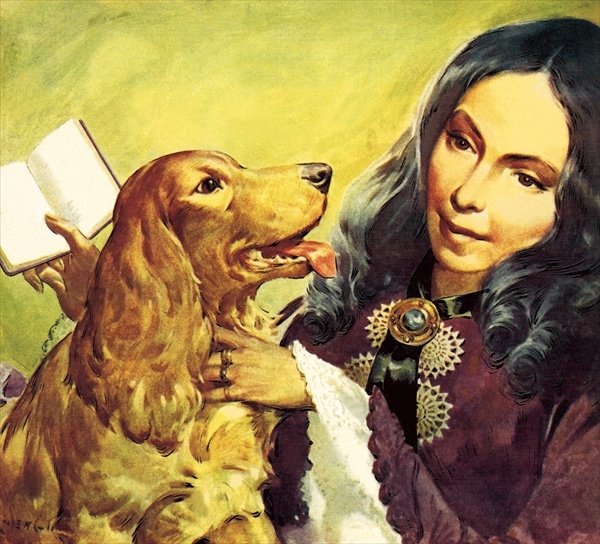
The Faithful Friend: Elizabeth Barrett Browning and her cocker spaniel Flush (Artwork: ames E McConnell)
Elizabeth Barrett Browning was deeply attached to her cocker spaniel, Flush, a gift from her friend Mary Mitford. In 1826, Browning?s first collection of poems, which revealed her passion for Greek politics, caught the attention of a man named Hugh Stuart Boyd, a blind scholar of the Greek language. The two became correspondents and lifelong friends. Nearly two decades later, in March of 1842, Browning wrote in a letter to Boyd, found in The Unpublished Letters of Elizabeth Barrett Browning to Hugh Stuart Boyd:
It was very kind in you to pat Flush?s head in defiance of danger and from pure regard for me. I kissed his head where you had patted it; which association of approximations I consider as an imitation of shaking hands with you and as the next best thing to it. You understand ? don?t you? ? that Flush is my constant companion, my friend, my amusement, lying with his head on one page of my folios while I read the other. (Not your folios ? I respect your books, be sure.) Oh, I dare say, if the truth were known. Flush understands Greek excellently well.
In 1850, having just given birth to her only son at the age of 43, after four miscarriages, Browning writes in a letter to her friend Mr. Westwood:
You can?t think what a good, sweet, curious, imagining child he is. Half the day I do nothing but admire him ? there?s the truth. He doesn?t talk yet much, but he gesticulates with extraordinary force of symbol, and makes surprising revelations to us every half-hour or so. Meanwhile Flush loses nothing I assure you. On the contrary, he is hugged and kissed (rather too hard sometimes), and never is permitted to be found fault with by anybody under the new regime. If Flush is scolded, Baby cries as matter of course, and he would do admirably for a ?whipping-boy? if that excellent institution were to be revived by Young England and the Tractarians for the benefit of our deteriorated generations.
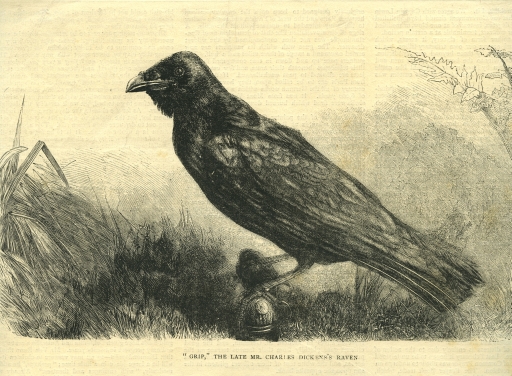
'Grip, The Late Mr. Charles Dickens's Raven' 1870 print (Image: Free Library of Philadelphia)
Charles Dickens had a beloved pet raven named Grip, who made frequent cameos in the writer?s fiction. In 1841, a few months after swallowing a paint chip, Grip perished. In a letter to his friend Daniel Maclise, found in The Selected Letters of Charles Dickens, Dickens pens a tongue-in-cheek sketch of Raven?s final moments:
Devonshire Terrace
Friday Evening
March The Twelfth 1841
My Dear Maclise
You will be greatly shocked and grieved to hear that the Raven is no more. He expired to-day at a few minutes after twelve o?clock, at noon. He had been ailing for a few days, but we anticipated no serious result, conjecturing that a portion of the white paint he swallowed last summer might be lingering about his vitals. Yesterday afternoon he was taken so much worse that I sent an express for the medical gentleman, who promptly attended and administered a powerful dose of castor oil. Under the influence of this medicine he recovered so far as to be able, at eight o?clock, P.M., to bite Topping [the coachman]. His night was peaceful. This morning, at daybreak, he appeared better, and partook plentifully of some warm gruel, the flavor of which he appeared to relish. Toward eleven o?clock he was so much worse that it was found necessary to muffle the stable knocker. At half-past, or thereabouts, he was heard talking to himself about the horse and Topping?s family, and to add some incoherent expressions which are supposed to have been either a foreboding of his approaching dissolution or some wishes relative to the disposal of his little property, consisting chiefly of half-pence which he has buried in different parts of the garden. On the clock striking twelve he appeared slightly agitated, but he soon recovered, walked twice or thrice along the coach-house, stopped to bark, staggered, exclaimed Halloa old girl! (his favorite expression) and died. He behaved throughout with decent fortitude, equanimity and self-possession. I deeply regret that, being ignorance of his last instructions.? The children seem rather glad of it. He bit their ankles but that was play?
After Grip died, Dickens had him taxidermied. Literary historians believe the bird inspired Edgar Alan Poe?s poem ?The Raven,? written shortly after Poe reviewed Dickens?s Bamaby Rudge, which features a talkative raven. Grip now lives in the Rare Books Department of the Free Library of Philadelphia.
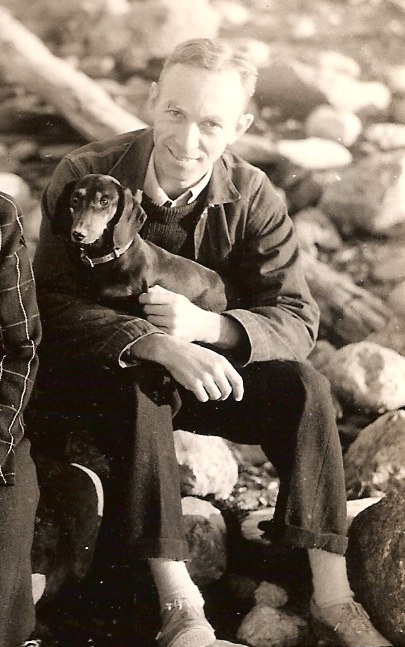
E. B. White sitting on the beach with his dog Minnie (Image: Wikimedia Commons)
In the Spring of 1951, E. B. White was accused by the New York chapter of the ASPCA for not paying dog tax on his beloved canine companion, Minnie. True to his eloquent wit, he responded with this letter of uncommon mischievous charm, found in the anthology Letters of a Nation:
12 April 1951
The American Society for the Prevention of Cruelty to Animals
York Avenue and East 92nd Street
New York, 28, NY
Dear Sirs:
I have your letter, undated, saying that I am harboring an unlicensed dog in violation of the law. If by ?harboring? you mean getting up two or three times every night to pull Minnie?s blanket up over her, I am harboring a dog all right. The blanket keeps slipping off. I suppose you are wondering by now why I don?t get her a sweater instead. That?s a joke on you. She has a knitted sweater, but she doesn?t like to wear it for sleeping; her legs are so short they work out of a sweater and her toenails get caught in the mesh, and this disturbs her rest. If Minnie doesn?t get her rest, she feels it right away. I do myself, and of course with this night duty of mine, the way the blanket slips and all, I haven?t had any real rest in years. Minnie is twelve.
In spite of what your inspector reported, she has a license. She is licensed in the State of Maine as an unspayed bitch, or what is more commonly called an ?unspaded? bitch. She wears her metal license tag but I must say I don?t particularly care for it, as it is in the shape of a hydrant, which seems to me a feeble gag, besides being pointless in the case of a female. It is hard to believe that any state in the Union would circulate a gag like that and make people pay money for it, but Maine is always thinking of something. Maine puts up roadside crosses along the highways to mark the spots where people have lost their lives in motor accidents, so the highways are beginning to take on the appearance of a cemetery, and motoring in Maine has become a solemn experience, when one thinks mostly about death. I was driving along a road near Kittery the other day thinking about death and all of a sudden I heard the spring peepers. That changed me right away and I suddenly thought about life. It was the nicest feeling.
You asked about Minnie?s name, sex, breed, and phone number. She doesn?t answer the phone. She is a dachshund and can?t reach it, but she wouldn?t answer it even if she could, as she has no interest in outside calls. I did have a dachshund once, a male, who was interested in the telephone, and who got a great many calls, but Fred was an exceptional dog (his name was Fred) and I can?t think of anything offhand that he wasn?t interested in. The telephone was only one of a thousand things. He loved life ? that is, he loved life if by ?life? you mean ?trouble,? and of course the phone is almost synonymous with trouble. Minnie loves life, too, but her idea of life is a warm bed, preferably with an electric pad, and a friend in bed with her, and plenty of shut-eye, night and days. She?s almost twelve. I guess I?ve already mentioned that. I got her from Dr. Clarence Little in 1939. He was using dachshunds in his cancer-research experiments (that was before Winchell was running the thing) and he had a couple of extra puppies, so I wheedled Minnie out of him. She later had puppies by her own father, at Dr. Little?s request. What do you think about that for a scandal? I know what Fred thought about it. He was some put out.
Sincerely yours,
E. B. White
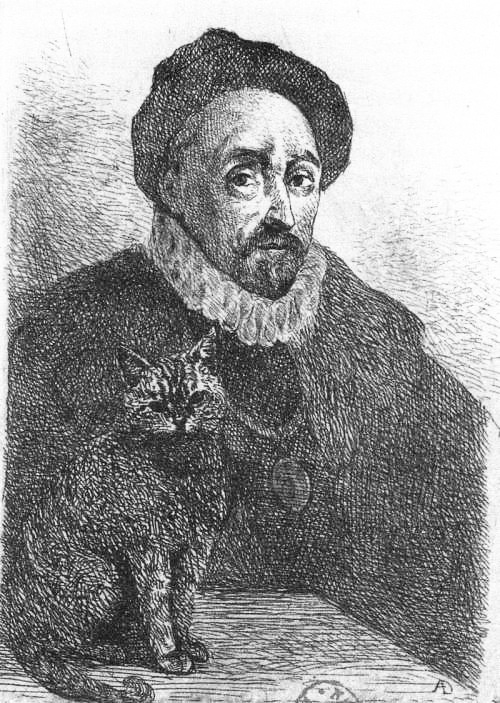
Montaigne and his cat
In one of his essays, admonishing against presumption, ?our natural and original disease,? Michel de Montaigne pondered the presumed indebtedness in the dynamic between him and his cat:
When I play with my cat who knows whether I do not make her more sport than she makes me? We mutually divert one another with our play. If I have my hour to begin or to refus, she also has hers.
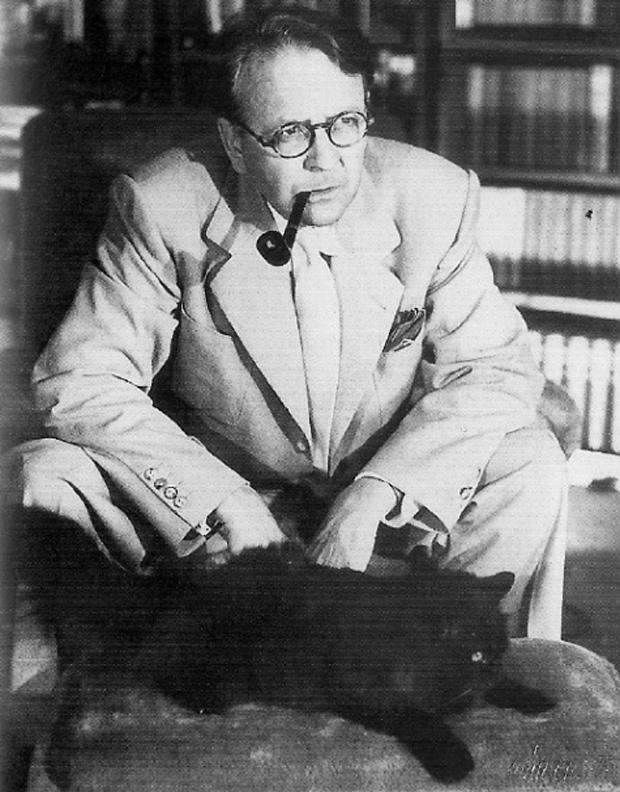
Raymond Chandler and Taki (Image: Venture Galleries)
The direction of ownership, in fact, is often inverted between cats and their owners. Take, for instance, Raymond Chandler and his beloved, temperamental cat Taki. In a 1948 letter to his friend James Sandoe, found in Selected Letters of Raymond Chandler, Chandler lovingly grumbles:
Our cat is growing positively tyrannical. If she finds herself alone anywhere she emits blood curdling yells until somebody comes running. She sleeps on a table in the service porch and now demands to be lifted up and down from it. She gets warm milk about eight o?clock at night and starts yelling for it about 7.30. When she gets it she drinks a little, goes off and sits under a chair, then comes and yells all over again for someone to stand beside her while has another go at the milk. When we have company she looks them over and decides almost instantly if she likes them. If she does she strolls over the plops down on the floor far enough away to make it a chore to pet her. If she doesn?t like them, she sits in the middle of the living room, casts a contemptuous glance around, and proceeds to wash her backside.
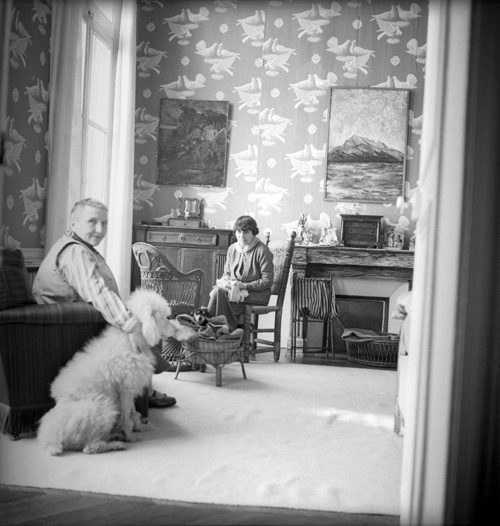
Gertrude Stein and Alice B. Toklas in wallpapered room, 1938; photograph by Sir Cecil Beaton (Image: Cecil Beaton Archives, Sotheby's, London)
Ever since reading Henry James?s The Princess Casamassima, Alice B. Toklas, the love of Gertrude Stein?s life, had always wanted a white poodle. So the couple got one and named him Basket. Basket was succeeded by Basket I and Basket II. The dogs were photographed by Man Ray and Cecil Beaton. In The Autobiography of Alice B. Toklas, Stein?s famously faux-titled biography of Toklas and their life together, Stein recounts the story of the first Basket:
We now had our country house, the one we had only seen across the valley and just before leaving we found the white poodle, Basket. He was a little puppy in a little neighborhood dog-show and he had blue eyes, a pink nose and white hair and he jumped up into Gertrude Stein?s arms. A new puppy and a new ford and we went off to our new house and we were thoroughly pleased with all three. Basket although now he is a large unwieldy poodle, still will get up on Gertrude Stein?s lap and stay there. She says that listening to the rhythm of his water-drinking made her recognize the difference between sentences and paragraphs, that paragraphs are emotional and that sentences are not.
Bernard Fay came and stayed with us that summer. Gertrude Stein and he talked out in the garden about everything, about life, and America, and themselves and friendship. They then cemented the friendship that is one of the four permanent friendships of Gertrude Stein?s life. He even tolerated Basket for Gertrude Stein?s sake. Lately Picabia has given us a tiny mexican dog, we call Byron. Bernard Fay likes Byron for Byron?s own sake. Gertrude Stein teases him and says naturally he likes Byron best because Byron is american while just as naturally she likes Basket best because Basket is a frenchman.
It was part of Stein and Toklas?s daily routine to brush Basket?s teeth each morning with his own toothbrush.
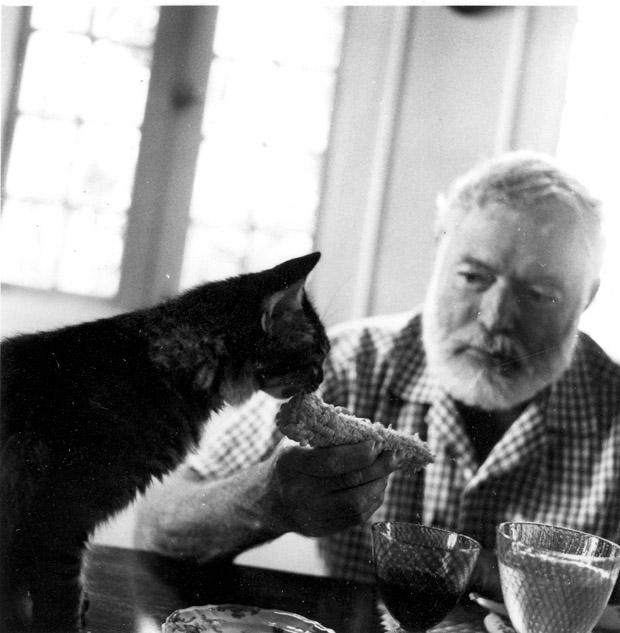
Hemingway and cat(Image: JFK Library)
Ernest Hemingway, despite his manly bravado, had a soft spot for cats. By 1945, he had amassed 23 of them. His niece writes in the foreword to Hemingway?s Cats: An Illustrated Biography that the author and his fourth wife, Mary, called the cats ?purr factories? and ?love sponges. On February 22, 1953, one of Hemingway?s cats, Uncle Willie, was hit by a car. Following the accident, Hemingway sent his close friend Gianfranco Ivancich the following distraught and stirring letter, originally featured here last year:
Dear Gianfranco:
Just after I finished writing you and was putting the letter in the envelope Mary came down from the Torre and said, ?Something terrible has happened to Willie.? I went out and found Willie with both his right legs broken: one at the hip, the other below the knee. A car must have run over him or somebody hit him with a club. He had come all the way home on the two feet of one side. It was a multiple compound fracture with much dirt in the wound and fragments protruding. But he purred and seemed sure that I could fix it.
I had Ren? get a bowl of milk for him and Ren? held him and caressed him and Willie was drinking the milk while I shot him through the head. I don?t think he could have suffered and the nerves had been crushed so his legs had not begun to really hurt. Monstruo wished to shoot him for me, but I could not delegate the responsibility or leave a chance of Will knowing anybody was killing him?
Have had to shoot people but never anyone I knew and loved for eleven years. Nor anyone that purred with two broken legs.
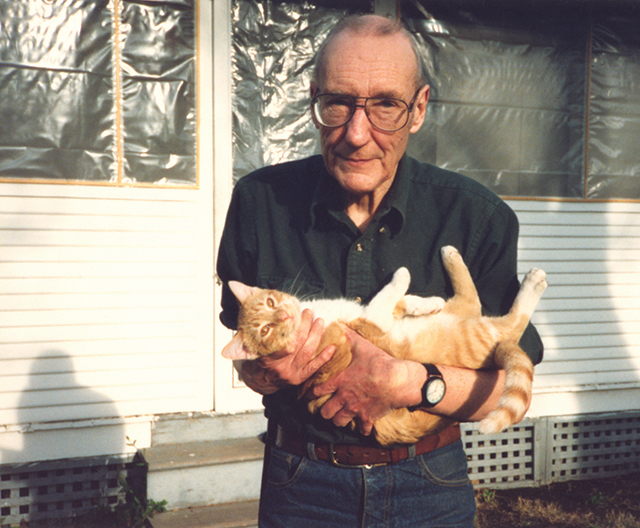
William S. Burroughs and his cat Ginger in the backyard of his home in Lawrence, Kansas
William S. Burroughs was a tremendous cat-lover? so much so that he cracked his coarse and often icy literary persona to reveal a gentler, warmer side in The Cat Inside. He adored his ?psychic companions,? Fletch, Ruski, Spooner, and Calico. Writing in his journal in June of 1997, he captures the near-telepathic minimalism to which communication between pets and their pet-parents is perfected:
Ginger touches me with her old paw when she wants something. She just touched me, and I let her out.
In the final entry of his journal, the very last words he ever penned, Burroughs bequeaths:
Thinking is not enough. Nothing is. There is no final enough of wisdom, experience ? any fucking thing. Only thing can resolve conflict is love, like I felt for Fletch and Ruski, Spooner, and Calico. Pure love.
Love? What is It?
Most natural painkiller what there is.
LOVE.
Pair with Lost Cat: A True Story of Love, Desperation, and GPS Technology and the indispensable The Big New Yorker Book of Dogs.
Donating = Loving
Bringing you (ad-free) Brain Pickings takes hundreds of hours each month. If you find any joy and stimulation here, please consider becoming a Supporting Member with a recurring monthly donation of your choosing, between a cup of tea and a good dinner:
You can also become a one-time patron with a single donation in any amount:
 Brain Pickings has a free weekly newsletter. It comes out on Sundays and offers the week?s best articles. Here?s what to expect. Like? Sign up.
Brain Pickings has a free weekly newsletter. It comes out on Sundays and offers the week?s best articles. Here?s what to expect. Like? Sign up.
?
Source: http://www.brainpickings.org/index.php/2013/04/29/literary-pets/
carrot top george huguely whitney houston casket photo match play championship the national enquirer marie colvin cm punk

 Jim Miller is 5-foot-8, fights at 155 lbs., and has a bushy red beard. Pat Healy is 5-foot-9, fights at 155 lbs., and sported a trimmed red beard at UFC 159. Can you blame UFC announcer Bruce Buffer for mixing them up?
Jim Miller is 5-foot-8, fights at 155 lbs., and has a bushy red beard. Pat Healy is 5-foot-9, fights at 155 lbs., and sported a trimmed red beard at UFC 159. Can you blame UFC announcer Bruce Buffer for mixing them up? The wonderful recent Lost Cat memoir, one of my favorite books of the past few years, reminded me of how central, yet often unsuspected, a role pets have played in famous authors? lives throughout literary history.
The wonderful recent Lost Cat memoir, one of my favorite books of the past few years, reminded me of how central, yet often unsuspected, a role pets have played in famous authors? lives throughout literary history.









 Brain Pickings has a free weekly newsletter. It comes out on Sundays and offers the week?s best articles. Here?s what to expect. Like? Sign up.
Brain Pickings has a free weekly newsletter. It comes out on Sundays and offers the week?s best articles. Here?s what to expect. Like? Sign up. 
 Autobots Assembled: How Transformers Come to Life
Autobots Assembled: How Transformers Come to Life Where the Toys Come From: Inside Hasbro?s Model Workshop
Where the Toys Come From: Inside Hasbro?s Model Workshop Michael Bay Is Why Transformers Got So Complicated
Michael Bay Is Why Transformers Got So Complicated Here's a Skinless, Laughing Elmo to Terrify You Forever
Here's a Skinless, Laughing Elmo to Terrify You Forever






 Disrupt NY 2013's Hackathon took place over roughly the last 24 hours, and now the teams are ready to present. Watch along as we live stream all 164 hacks built during the event, each of which gets just under a minute to demo what they've built on stage in order to try to convince the judges they're worthy of the sponsor prizes. 164 is a lot of hacks for just under a day, and in fact it's a record for any Disrupt Hackathon to date.
Disrupt NY 2013's Hackathon took place over roughly the last 24 hours, and now the teams are ready to present. Watch along as we live stream all 164 hacks built during the event, each of which gets just under a minute to demo what they've built on stage in order to try to convince the judges they're worthy of the sponsor prizes. 164 is a lot of hacks for just under a day, and in fact it's a record for any Disrupt Hackathon to date.